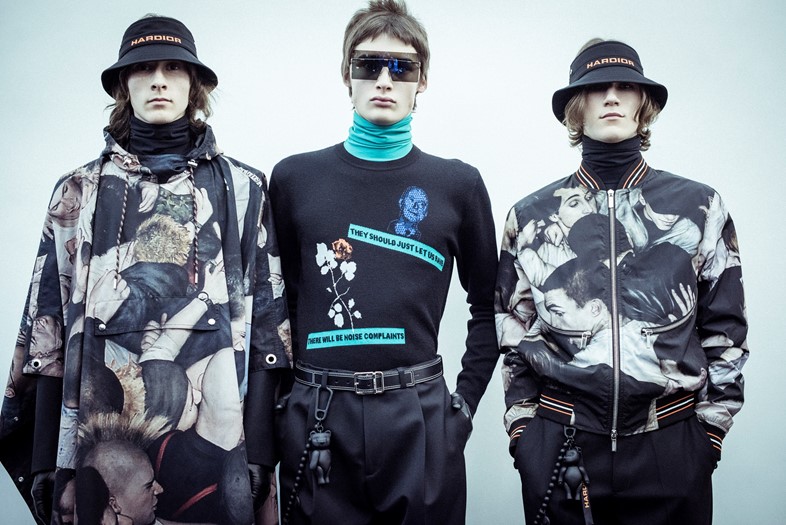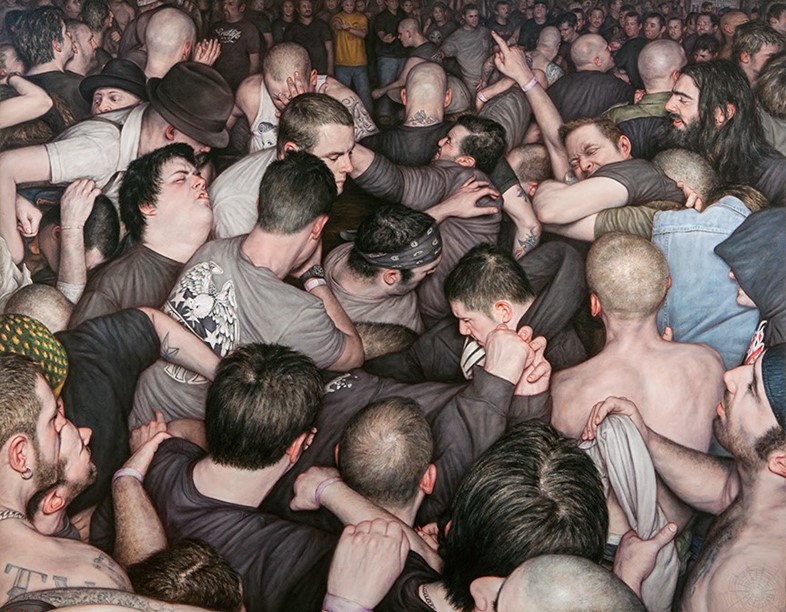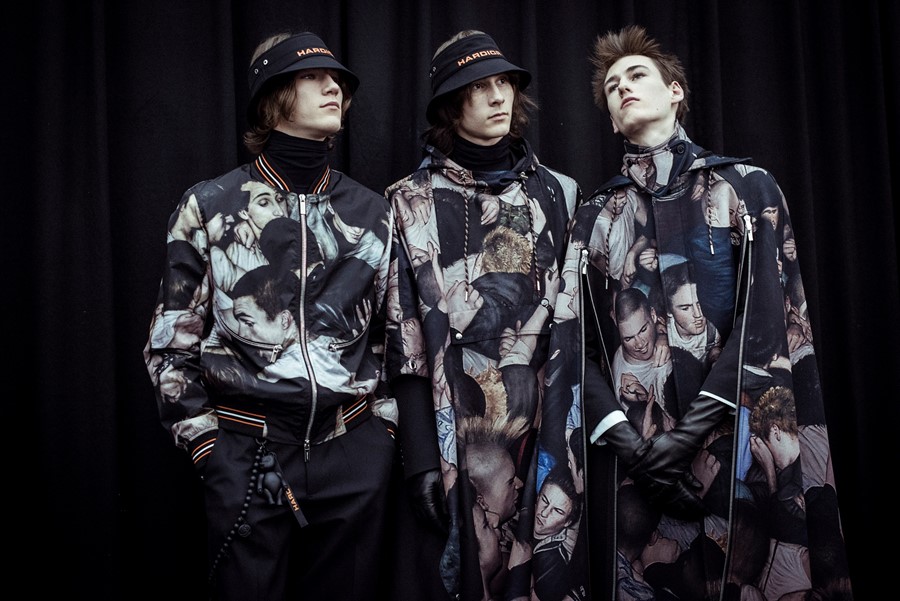We speak to the artist whose Mosh Pit paintings played a crucial role in combining the energy of hardcore with the beauty of the Old Masters for the new collection
With repercussions from Brexit, news of Trump and the rise of the so-called alt-right throughout the West in recent months, it feels like the world is spiralling into chaos, or else at least back to the Dark Ages. It comes as little surprise, then, that many fashion designers used the A/W17 menswear shows this January to respond to this political turmoil. While some, like Craig Green, imagined collections designed to evoke a sense of comfort, others turned to a more expressive coping mechanism: partying. Christopher Shannon, among others, referenced rave culture, along with the hedonism and “Peace, Love, Unity, Respect” politics the movement endorsed.
Another designer who looked at the idea of parties and subcultural gatherings was Kris Van Assche at Dior Homme, who referenced rave, along with New Wave, the gabbers and the candy boys. This translated to a line of contemporary, youth-infused tailoring, all of which was imbued, in the designer’s words, with “a pure and raw ‘Dior’ attitude”. It truly was raw, and, as exemplified in the “HarDior” logo smattered throughout the collection, hardcore Dior.
This idea of rawness and rave came through in a very literal way too: tailoring was cut from cloth bearing artist Dan Witz’s Mosh Pits paintings – compelling photorealist portrayals of the thronging crowds at music concerts. Based in New York, Witz once played in bands himself before retiring from music and taking up painting full-time. He continued to express his love for live music and the chaos of those environments through his painting, beginning his Mosh Pits series in 2000. The series was duly celebrated in a solo exhibition – attended by Van Assche – titled NY Hardcore in 2014.
Like the surprising love child of Géricault’s The Raft of the Medusa and Derek Ridgers’ documentations of London’s nightlife, these works have both the grandeur of historic painting and the ‘warts and all’ realism of club photography. Transposed onto fabric, Witz's figures appeared on Dior Homme’s A/W17 runway in the form of two slim fit suits, two poncho-style rain coats and one sporty-looking bomber jacket. Here, Van Assche shares what motivated him to incorporate Witz’s paintings into the collection, while the artist himself tells us more about the series and the reason gigs interest him so much.

Kris, what inspired your A/W17 collection for Dior Homme?
Kris Van Assche: “The starting point of this collection was actually very ‘Dior Homme’ with a new version for tailoring with close-fitted jackets, hand-stitching worked inside-out and leather gloves in homage to Monsieur Dior. But it is also a celebration of teenage memories, with strong references to New Wave, rave parties, gabbers and candy boys: a double-edged silhouette where sartorial meets street.”
Why did you decide to incorporate Dan Witz’s Mosh Pits paintings?
Kris Van Assche: “Dan Witz is one of the pioneers of street art. I first discovered his work a few years ago when I fell upon a series of his earlier street-art works called Hoodies. I also loved his hyper-realistic interpretation of the Mosh Pits presented in the exhibition New York Hardcore. The raw energy of punk rock chaos which prevails in these paintings clearly echoed the idea of subcultural gatherings and rave parties which were such a fundamental inspiration in the collection.”
Dan, what are you trying to capture in your Mosh Pits paintings?
Dan Witz: “Most artists make the kind of art they want to see themselves – in my case that’s usually some form of realistic painting. Ever since I was a kid I’ve been fascinated by the Old Masters, the almost magical sense of light and presence they get in their canvases. Historically, the highest form of that kind of painting is the large multi-figure history works – those huge writhing battle scenes you hurry past in the museum on your way to the Impressionists or the Rembrandts. Obviously the content in those old academic potboilers is stultifyingly obsolete: my goal is to capture that energy and magic sense of light and space, but update the genre with modern more resonant narratives.”

Where did you first get the idea?
Dan Witz: “After I got out of art school, for most of my 20s I played in punk-type bands. When I ‘retired’ from music (got too old) and went back to making art full-time, I was concerned that painting wouldn’t have the same level of intensity as performing – that my life and work would lack risk – or, (I know it’s a cliché, but back then this is how I thought): I was worried that I’d lose my ‘edge’. It took me a few years to develop my skills, but going to concerts and photographing in the pit, then puzzling together these fiendishly complicated compositions, then spending endless months in the studio battling the canvas – this has more than satisfied my need for heroic adventures.”
What is it about gigs that interests you?
Dan Witz: “Hardcore is a durable subculture. By the time I got to punk rock in the late 70s, the truly transgressive part was over. Mostly what was left was hair and fashion – the ‘we don’t care what the fuck you think of us’ attitude (that I loved) was gone. Hardcore though is famously less mercurial: there’s a pureness at its centre that has stood the test of time. Also, the base impulse of hardcore that inspires my paintings – that barbaric YAWP that sounds over the rooftops of the world (Walt Whitman) – this seems to get louder and even more urgent every day.”
